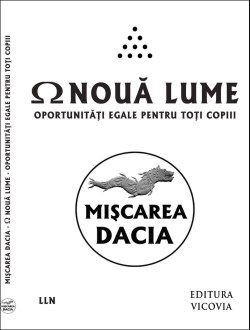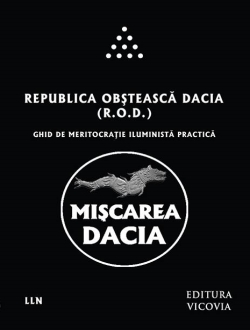Academia Iluministă (3)
Maggio 5th, 2019 Posted in Mişcarea Dacia
THE MYERS-BRIGGS MATHEMATICAL TYPES
What type of people can hope to understand mathematics? We contend that as a generality only four of the sixteen Myers-Briggs personality types can be seriously mathematically literate.
First of all, to be mathematically skilled you have to be an introvert. Our definition of introvert is a simple one. An introvert is someone who enjoys his own company and does not go out of his way to seek the company of others. An extravert, on the other hand, enjoys the company of others and goes out of his way to avoid being on his own. To be a mathematician, you must have tremendous concentration, which implies being on your own without distractions. An extravert, continually distracted by the company he cultivates, never has the time and opportunity to be a deep thinker. Profound thinking is almost exclusively reserved for people capable of being solitary for long periods.
Secondly, mathematicians are usually highly intuitive. They can tune in, so to speak, to the mathematical fabric of the universe. Numbers, shapes and patterns present themselves as gifts to intuitives.
Thirdly, mathematicians are highly likely to be thinkers. While entertainment is the terrain that appeals to feeling and sensing types, mathematics, science and philosophy appeal to thinkers. Thinkers like cold abstractions, vast patterns, ordered lists, organised building blocks, while entertainment types wallow in the sensations and feelings that words, images and action summon in their imagination.
The four psychological types that predominantly fill the ranks of mathematicians are: INTJ, INTP, INFP and ISTP.
ISTPs and INFPs are the second rank of mathematicians. In the ISTP case, these mathematicians are highly observant about the world they detect with their eyes and ears (they often love music), but they have a severe deficiency through their lack of intuition. INFPs are highly intuitive and can even feel mathematics to some extent, but they are hindered by their deficiency in terms of high-powered thinking.
INTJs and INTPs are the first rank of mathematicians. INTJs are incredibly intuitive and have enormous thinking power to accompany those intuitions. Similarly, INTPs have vast thinking capacity supported by great intuition. The difference between the INTJs and INTPs is that the former reach judgments much more quickly. They grasp the significance of an intuition almost instantly. Almost effortlessly, they see vast patterns forming in their minds, linking things that would seem to have no connection at all as far as other Myers-Briggs types are concerned. However, their certainty that they are right means that they are not overly concerned with proving their assertions, and proof is of course essential to the mathematical project. INTPs are the “details” people, the thinkers willing to dot the i’s and cross the t’s. They are mathematicians in the truest sense of the word, but they are not as quick to see and understand patterns as the INTJs. The ideal mathematician would be someone who was a perfect hybrid of INTJ and INTP.
In this series of books, we are not committed to providing laborious and intimidating mathematical proofs. Instead, we want to use just enough mathematics to provide solid conceptual foundations. In other words, this series is written from the INTJ perspective and we invite any INTPs who may be reading this to fill in all of the details we will of necessity omit. This book is about broad-stroke mathematical concepts, not mathematical proofs. If we adopted the INTP approach, this book would be the most daunting ever written and incomprehensible to anyone other than mathematicians. Our aim is to give an intelligent person, without a mathematical background, enough information to glimpse and grasp the mathematical basis of reality, and to appreciate its astonishing power, beauty and simplicity.
Although the mathematical foundations of existence are indeed simple, the concepts that flow from them are mind-bogglingly difficult and baffling. The contents of this series will provide the greatest intellectual challenge of your life.
Gottfried Leibniz, a Grand Master of the Illuminati and perhaps the greatest thinker of all time, declared that the best world is the one which is “simplest in hypotheses and richest in phenomena”. This is not just the formula for the best world but for the ONLY world. The world pursues the path of least resistance. It takes the shortest path it can between two points. It never expends energy gratuitously. From the world’s point of view, everything is as simple as it could possibly be. That might not seem the case from our perspective as human beings, but that’s the way it is.
By the end of this series, you will hopefully have a full understanding of the simple “hypotheses” from which the world is built and you will marvel at the astonishing complexity and richness that flows from them. Yet the apparent complexity is a product not of Nature but of the false “common sense” view of the world that humanity has constructed based on numerous fallacies. Even science, humanity’s most successful endeavour, is packed with errors caused by paying too much attention to our unreliable senses and not enough to our potentially infallible reason. For example, we see colours all around us yet a logical deconstruction of the concept of colour shows that the world does not objectively contain any colour at all. As neuroscientist Beau Lotto said, “Colour doesn’t exist. It is a construct of your brain. There is nothing literal about colour in the world.” If all human beings had the genes for total colour blindness, it would never even have occurred to anyone that the sky was blue or that there was any such phenomenon as colour.
What does it mean to assert that our genes are the “cause” of colour perception? The genes belong to us and not to the objects that allegedly exhibit the colour. Is Kant therefore right that our minds are creating their own reality independent of the true world? But no one can question the rational mathematical statement that 1 + 1 = 2. That is an eternal, incontestable, immutable truth. Reason, not our senses, reveals the absolute truths of existence. Our senses continually deceive us. They were not designed as organs of truth but as means for allowing us to adapt successfully to life on earth.
We see only a tiny portion of the electromagnetic spectrum – “visible light”. The rest of the spectrum is invisible to us. Until Scotsman James Clerk Maxwell’s revolutionary theory of electromagnetism arrived in the second half of the 19th century, we had no idea what light really was and knew nothing about any electromagnetic spectrum. Our senses failed to detect any such spectrum because it’s not what they were designed for. They evolved for reasons of survival, not reasons of truth or completeness. So why do scientists so slavishly revere the evidence of our senses and have such contempt for the exercise of the highest and purest reason?
Reason alone can reveal the absolute truth of existence, and what subject is the essence of reason? – *Mathematics*.
Although mathematics is conventionally regarded as an abstract tool, we shall introduce a second type of mathematics that we have labelled “ontological mathematics”. This means that is does not treat mathematical entities as mere paper abstractions and symbols but as things with real existence. Ontological mathematics might also be called the mathematics of energy since that’s what it’s fundamentally about. Numbers written on paper have no energy content. Numbers written in spacetime most certainly do. Manipulation of numbers on paper has no energy implications, but it does in spacetime. Things that can be done effortlessly on paper may not be possible ontologically because of these energy considerations: this is the fundamental difference between abstract and ontological mathematics.
Think of all the sub-atomic particles listed by scientists. Do any of these particles have any properties that cannot be characterised mathematically? There isn’t a single thing about them that isn’t defined by numbers, shapes, quantities, dimensions and mathematical formulae i.e. all the stuff of mathematics. So in what way are these objects of science rather than objects of mathematics? It’s only because we (humanity) have chosen to think of mathematics as fundamentally unreal and abstract that we perversely regard objects that are in every way defined mathematically, and which have no non-mathematical features, as objects of science rather than of mathematics.
Quantum mechanics, relativity theory and M-theory (the theory that is trying to harmonise quantum mechanics and relativity) are all astoundingly mathematical. Are these scientific theories or ontological mathematical theories? If we rebrand science as ontological mathematics then it becomes much clearer why abstract mathematics reflects science so well: “science” is just mathematics as reality rather than as abstraction.
There’s a gulf between conventional science and ontological mathematics in terms of three critical numbers: zero, infinity and the imaginary number, i. Conventional science, an expression of extreme philosophical materialism, asserts that zero, infinity and the imaginary number have no ontological reality within any region of space and time. Conventional science involves a hypothesis that only real numbers are ontological or have any bearing on reality. There is not a single rational reason why this should be the case: it is pure empiricist materialist dogmatism. Science refuses to address the issue of why it accepts only real numbers greater than zero and less than infinity. It gives no rational reason for rejecting zero, infinity, negative numbers and imaginary numbers beyond the simplistic one that they are not empirically detectable. Science thus enshrines empiricist materialism in how it regards mathematics. This is not a scientific but a philosophical stance, and indeed a faith-based position since the ontology of mathematics is not something that can be determined via fallible human senses.
Abstract mathematics – which has no ideological hostility to zero, infinity and the imaginary number (or negative numbers for that matter) – is considered irrelevant to science in respect of these key numbers. Any scientist will tell you that nothing infinite can exist within any localised region of reality because it would literally destroy the fabric of existence in that region, and no such catastrophic tears are observed except, arguably, in the specific cases of the mysterious singularities associated with black holes and the Big Bang. Scientists maintain that there is something wrong with the existing scientific theories regarding singularities and their dreaded infinities and that these problems will be resolved by some new theory such as M-theory.
Scientists will also tell you that they associate zero with non-existence i.e. it is devoid of ontological significance. Descartes defined *res cogitans* (thinking substance) as having no extension i.e. it had no presence in the extended world of matter. Scientists, as strict materialists, have dismissed the Cartesian concept of independent thinking substance (mind). Mind, for scientists, is a mysterious aspect of matter. It cannot exist separately from matter, hence is some kind of material phenomenon or epiphenomenon. According to science, the Cartesian mind, the domain of zero, is pure nonsense. It simply isn’t there. Of all the catastrophic errors of science, this is the greatest because it turns out that zero is the quintessence of existence and completely defines it.
As for the imaginary number, i, this appears in a vast number of scientific equations, yet scientists regard it as purely instrumental i.e. it helps to produce the right answers but has no ontological reality. Mathematician Marcus du Sautoy declared, “Calculating with imaginary numbers is the mathematical equivalent of believing in fairies.” It seems extraordinary that extremely highly qualified individuals should accept “fairies” in the midst of some of the most successful theories and equations of all time and not conclude that either these theories and equations are the purest moonshine, or else imaginary numbers are anything but imaginary. It is poverty of both reason and imagination that makes mainstream scientists and mathematicians so blind to the ontological reality of imaginary numbers. There are no “fairies” in mathematics. Neither zero, infinity nor imaginary numbers are fairies. On the contrary, they are essential to existence. They are the most solid, substantial entities of them all, every bit as solid and ontological as real numbers.
So, Illuminism defines two types of mathematics: abstract (conducted purely in the mind or on paper) and ontological (that unfolds as reality itself) – the two are of course extremely closely related, with energy being what separates them. Ontological mathematics can be further divided into ontological mathematical materialism (science) and ontological mathematical idealism (the mathematics of zero and infinity).
The imaginary number belongs to mathematical materialism (though scientists haven’t grasped this yet). What this means is that the imaginary number has real existence in the physical world – which is why it appears in so many key equations of science. It is not an instrument for getting the right answer: it is part of the fabric of reality. In fact, it is the basis of time.
The two branches of ontological mathematics constitute a complete account of reality – a grand unified theory if you will. What the two branches achieve is the resolution of Cartesian dualism.
Descartes divided reality into two separate domains of mind and matter but could not give any plausible explanation of how the two domains interact. Despite being a brilliant mathematician and acknowledging that mathematical knowledge is the primary source of truth, Descartes failed to make the intuitive leap that would have made him a god amongst men. He didn’t grasp that mind belongs to the mathematical domain of zero and infinity while matter belongs to the mathematical domain of everything that exists between those two numbers, and that together they embrace everything that can possibly exist from zero to infinity in all directions. There is therefore no dualism at all between mind and matter: they are part of a seamless mathematical continuum and they communicate and interact effortlessly via their common language of mathematics. It’s the unique properties and qualities of zero and infinity that separate them from the rest of mathematics and make mind seem radically different from matter. In fact, the two domains are just different manifestations of ontological mathematics. There is no dualism, no mystery, no magic, no baffling enigma of how mind and matter interact. They are not two different substances but the same substance – mathematical substance.
Where science regards mathematics as an invaluable tool for revealing the secrets of the scientific world, Illuminism regards science as an invaluable tool for helping to reveal the secrets of the mathematical world. Mathematics is not only the answer to Cartesian dualism but also to the Kantian dualism of noumenon and phenomenon. In fact, these two dualisms are ultimately the same.
The noumenal realm was originally defined by Plato as the world of ideas apprehended by the philosophical, rational mind while the phenomenal realm was the world of sensory reality in which the unphilosophical and animalistic were permanently trapped i.e. their primitive minds could never take them to the noumenal domain. The tendency of modern philosophy is to support science in denying the possibility of knowledge gained independently of the senses. Kant famously asserted that although the noumenal world exists, it is entirely unknowable; we can only ever grasp phenomenal reality. Science agreed that we can know only the material world and simply denied that there was any noumenal world at all, just as it had previously denied that there was any Cartesian domain of mind and any religious domain of soul. Science, like Doubting Thomas, says no to anything it can’t empirically detect.
Illuminism, on the other hand, asserts that the noumenal domain not only exists, it is primary, the ground of existence. Moreover, phenomenal and noumenal reality are both fully knowable via mathematics – because all phenomena and noumena are mathematical entities.
Science, hitherto, has been the tool for probing the empirical, material, phenomenal world while metaphysics (literally “what comes after physics”) is the term traditionally applied to the study of the noumenal universe. Religion also makes comments about the noumenal universe but in a faith-based, irrational, idiotic way where the statements of prophets and holy texts are regarded as some sort of absolute “truth” revealed by “God”. We shall ignore the claims of mainstream religion since they are more or less absurd. The Western Abrahamic religions of faith quite literally have zero truth content, and the Eastern religions are far too mystical and imprecise. The “God” of Abrahamism is as far from truth, reason, logic, enlightenment and reality as you could get. He is the false God, the God of the stupid and irrational and all those who have contempt for the truth. “The truth shall set you free” is the most ironic statement conceivable in the mouth of an Abrahamist.
Science has proved spectacularly successful while metaphysics has been speculative and resulted in no definitive view or consensus, hence science has become the basis of modern rational thinking and has relentlessly promoted empiricism, materialism and atheism.
Illuminism asserts that the only way to save metaphysics is via mathematics since a) mathematics IS reality and b) mathematics is the only subject about which anything precise can be said. Science’s power derives from the fact that it uses mathematics and metaphysics doesn’t. Metaphysics should be rebranded as the “philosophy of ontological mathematics”, along the same lines as the philosophy of science.
One of the greatest tragedies of science is that most scientists are not only ignorant of philosophy but also actively hostile towards it. Such scientists dismiss the philosophy of science which seeks to philosophically clarify what the findings of science actually mean. One of the greatest philosophers of science was Thomas Kuhn and his book *The Structure of Scientific Revolutions* is a full-scale assault on the pretensions and delusions of scientists. It was Kuhn who introduced the famous concept of the “paradigm shift”. Even today, the vast majority of scientists have never read Kuhn, hence don’t realise how he fatally undermined much of the ideology and dogmatism of science.
Kuhn believed that scientists had a great deal to learn from the study of the history of science and Illuminism agrees entirely with this. In fact, the same is true of every subject. Unless you understand something’s history, you don’t have any deep understanding of it at all. You don’t know how it came to be where it is and what debates, controversies, dilemmas, difficulties and dialectics fuelled the journey. Scientists, sadly, are as ignorant of the history of science as they are of the philosophy of science – hence are much less effective at science itself. The teaching of science should always begin with the history and philosophy of the subject before people start learning science itself. The same is true of mathematics.
Although we are asserting that mathematics is the truth of reality, this book (and series) is not primarily a mathematics textbook. Rather, we will be examining the philosophy of particular mathematical concepts and showing how they define such apparently scientific phenomena as space and time.
Space and time go right to the heart of ontological mathematics and not a thing can be truly understood about the material world if a person is ignorant of the mathematical origins of space and time. It’s a fact that no one outside the Illuminati has ever understood space and time and, in this series, we will reveal the truth to everyone.
The primary tools for understanding ontological mathematics are abstract mathematics, science and philosophy. Ontological mathematics should be regarded as the grand synthesis of mathematics, science and philosophy, turning them into one unified subject rather than three separate subjects. In doing so, it addresses all of the questions of religion. It brings religion into the domain of facts, evidence, reason, logic and, above all, mathematics. All faith-based elements of religion are exposed as ignorant, irrational, superstitious, crazy nonsense that feeds the madness of stupid fanatics, with whom our world is plagued – particularly in the case of Orthodox Jews, Muslims (more or less all of them) and Christian Fundamentalists.
Tags: Academia Iluministă











